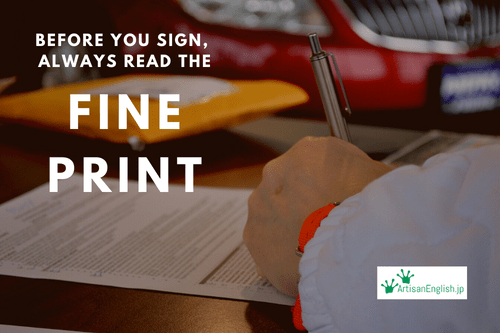
YouTube / iTunes / Spotify / Radio Public / Pocket Casts / Google Podcasts / Breaker / Overcast
Listen to ArtisanEnglish.jp posts & lesson intros here.
WotD: Fine print
How often have you read the fine print before accepting the terms of usage for an app or computer software?
I’m willing to bet that if you are like me, you’ve never read a ‘terms of use’ contract in its entirety.
Those things are B-o-r-i-n-g with a capital ‘B.’
They’re full of legal jargon that nobody can understand.
The fine print is the small print at the end of contracts, which contains all the critical details.
It’s usually quite long and written in smaller-than-usual print to save space.
The best advice is that you should always take your time and read it before signing on the dotted line.
The truth is, most of us don’t.
I chose fine print to be the word of the day because it was the topic of a New York Times article recently.
The Hudson Yards project is a massive mixed-use construction project of residences, offices and retail space over the Hudson Railway yards.
Recently, a huge public artwork called The Vessel was opened to the public.
If you are looking for a way to cut back on some middle-age spread, you may want to go and take a look at it next time you’re in The Big Apple.
It’s a 150-foot-high structure and nothing but stairs.
That’s not my main point today.
The owners of this structure have the right to use any and all pictures of The Vessel posted online.
That means if you take a picture of it, they can use that picture in advertisements, and you will get no money for it.
It’s all written in the fine print of its terms of service, which is conveniently (???) only available online.
If you notice, I have no picture of The Vessel here and never will.
These days, you always have to read the fine print, even if you don’t know it’s there for you to read.
Flesch-Kincaid Readability Test
This post is understandable by someone with at least a 7th-grade education (age 12).
On the Flesch-Kincaid reading-ease test, this post scores 76.
The easier a passage is to read, the higher the score on a scale of 0 – 100.

